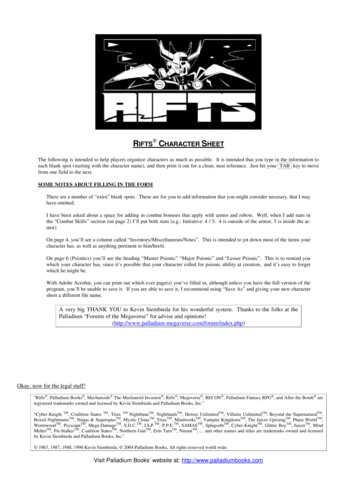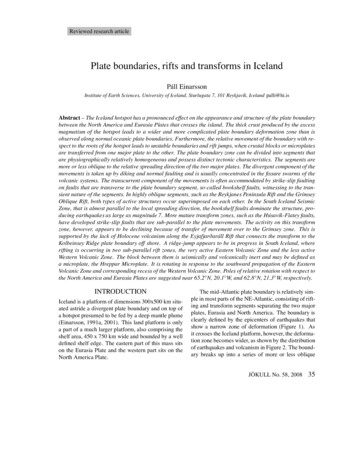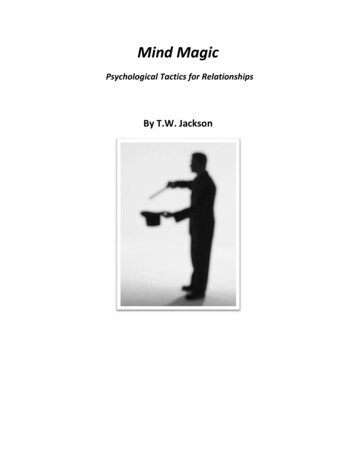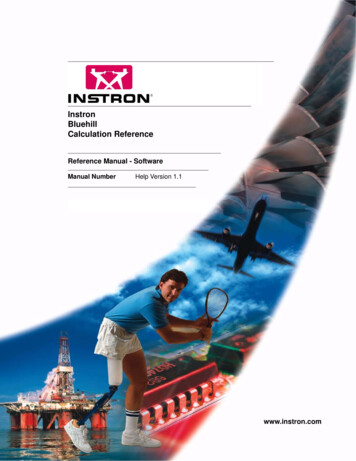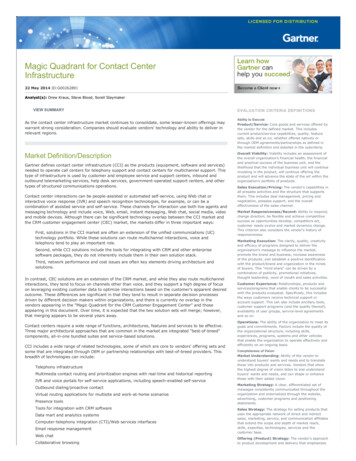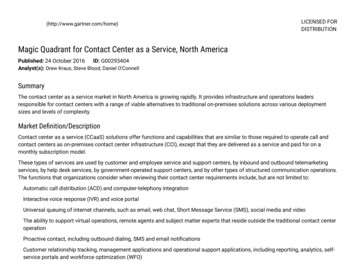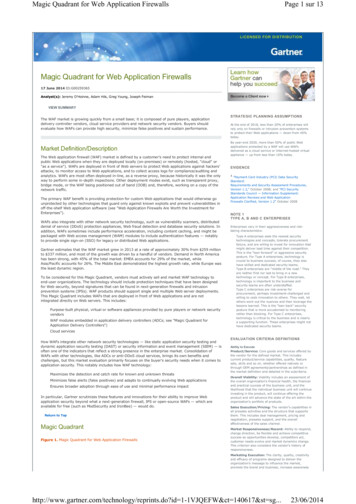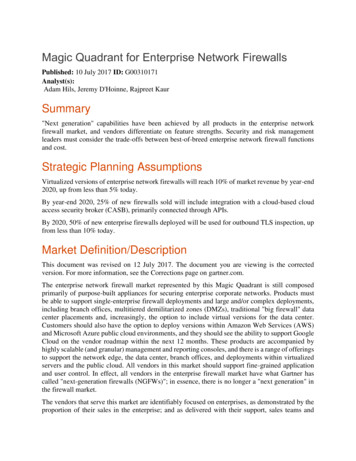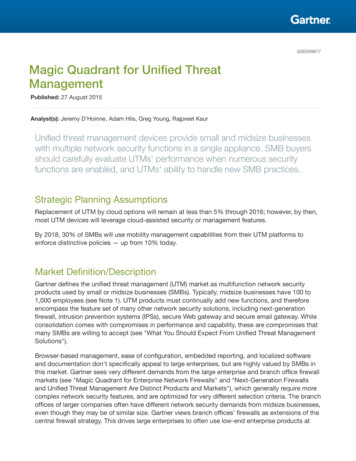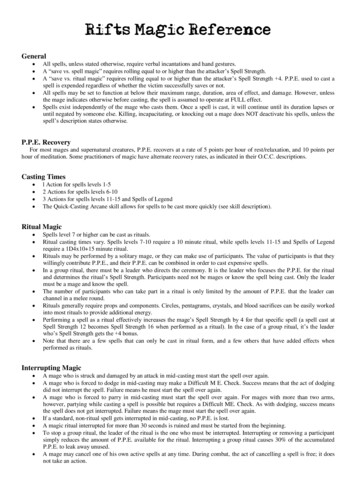
Transcription
Rifts Magic ReferenceGeneral All spells, unless stated otherwise, require verbal incantations and hand gestures.A “save vs. spell magic” requires rolling equal to or higher than the attacker’s Spell Strength.A “save vs. ritual magic” requires rolling equal to or higher than the attacker’s Spell Strength 4. P.P.E. used to cast aspell is expended regardless of whether the victim successfully saves or not.All spells may be set to function at below their maximum range, duration, area of effect, and damage. However, unlessthe mage indicates otherwise before casting, the spell is assumed to operate at FULL effect.Spells exist independently of the mage who casts them. Once a spell is cast, it will continue until its duration lapses oruntil negated by someone else. Killing, incapacitating, or knocking out a mage does NOT deactivate his spells, unless thespell’s description states otherwise.P.P.E. RecoveryFor most mages and supernatural creatures, P.P.E. recovers at a rate of 5 points per hour of rest/relaxation, and 10 points perhour of meditation. Some practitioners of magic have alternate recovery rates, as indicated in their O.C.C. descriptions.Casting Times l Action for spells levels 1-52 Actions for spells levels 6-103 Actions for spells levels 11-15 and Spells of LegendThe Quick-Casting Arcane skill allows for spells to be cast more quickly (see skill description).Ritual Magic Spells level 7 or higher can be cast as rituals.Ritual casting times vary. Spells levels 7-10 require a 10 minute ritual, while spells levels 11-15 and Spells of Legendrequire a 1D4x10 15 minute ritual.Rituals may be performed by a solitary mage, or they can make use of participants. The value of participants is that theywillingly contribute P.P.E., and their P.P.E. can be combined in order to cast expensive spells.In a group ritual, there must be a leader who directs the ceremony. It is the leader who focuses the P.P.E. for the ritualand determines the ritual’s Spell Strength. Participants need not be mages or know the spell being cast. Only the leadermust be a mage and know the spell.The number of participants who can take part in a ritual is only limited by the amount of P.P.E. that the leader canchannel in a melee round.Rituals generally require props and components. Circles, pentagrams, crystals, and blood sacrifices can be easily workedinto most rituals to provide additional energy.Performing a spell as a ritual effectively increases the mage’s Spell Strength by 4 for that specific spell (a spell cast atSpell Strength 12 becomes Spell Strength 16 when performed as a ritual). In the case of a group ritual, it’s the leaderwho’s Spell Strength gets the 4 bonus.Note that there are a few spells that can only be cast in ritual form, and a few others that have added effects whenperformed as rituals.Interrupting Magic A mage who is struck and damaged by an attack in mid-casting must start the spell over again.A mage who is forced to dodge in mid-casting may make a Difficult M E. Check. Success means that the act of dodgingdid not interrupt the spell. Failure means he must start the spell over again.A mage who is forced to parry in mid-casting must start the spell over again. For mages with more than two arms,however, partying while casting a spell is possible but requires a Difficult ME. Check. As with dodging, success meansthe spell does not get interrupted. Failure means the mage must start the spell over again.If a standard, non-ritual spell gets interrupted in mid-casting, no P.P.E. is lost.A magic ritual interrupted for more than 30 seconds is ruined and must be started from the beginning.To stop a group ritual, the leader of the ritual is the one who must be interrupted. Interrupting or removing a participantsimply reduces the amount of P.P.E. available for the ritual. Interrupting a group ritual causes 30% of the accumulatedP.P.E. to leak away unused.A mage may cancel one of his own active spells at any time. During combat, the act of cancelling a spell is free; it doesnot take an action.
The Effects of Ley Lines & Nexus Points Being within two miles of a ley line or nexus point increases the range and duration of all spells by 50%.Being directly at a ley line or within 1 mile of a nexus point doubles the range, duration, and damage of all spells.Being directly at a nexus point triples the range, duration, and damage of all spells, and increases personal Spell Strengthby 1. The rnage also gets 2 to Save vs. Magic and 2 to Save vs. Horror Factor.When directly at a ley line, most mages can draw 10 P.P.E. per melee round; not cumulative.When directly at a nexus point, most mages can draw 20 P.P.E. per melee round; not cumulative.The Effects of Armor Armor made from natural materials (leather, animal hide, etc.) does not interfere with spell casting.When it comes to channelling P.P.E., metal and most synthetic materials act as insulators (basically, metal is to magicenergy what rubber is to electricity). Metal body armor or body armor made from synthetic materials (plastic, ceramics,etc.) covering more than 50% of the body requires the mage to spend 20% more P.P.E. to cast a spell. The mage mustalso roll on the following table to determine how else the spell is affected. These rules also apply to spellcasting whileinside power armor. Vehicles offer enough space as to not directly provide interference.01-20%: Reduce spell damage or effects by 1D4x10%.21-40%: Reduce spell duration by 1D4x10%.41-60%: Reduce the spel1’s range by 1D4x10%.61-80%: Reduce both the duration and the range of the spell by 20%.81-100%: Lucked out, no additional problems.The Effects of Cybernetics & Bionics A mage can tolerate one minor cybernetic implant (such as a clock calendar or gyro-compass) without suffering any illeffects.Two to three isolated minor cybernetic or bionic implants, or one major implant (such as a full cybernetic arm), willreduce a mage‘s Personal P.P.E. Reserve by half. Furthermore, the mage will be unable to draw on other sources ofP.P.E., such as P.P.E. batteries, ley lines, and nexus points!Anything more than three minor implants or one major implant will completely negate the rnage’s magical capabilities!Magical regeneration may cause the subject’s body to reject and expel cybernetic or bionic implants, unless thoseimplants are biosystems.The Limitations of Magic Spells are either resisted (meaning that they require a Save vs. Magic), or defensible (meaning that they are parried ordodged, just like regular physical attacks).Most spells work best when there is a fairly unobstructed line of sight with the target. “Line of Sight” isn’t limited toeyesight, and can include visual contact via real-tirne video, magical scrying, or other indirect means.Casting spells on targets outside one’s line of sight (such as someone inside a closed building or vehicle) is certainlypossible, unless the spell specifically requires line of sight. The target gets 5 to Save vs. Magic (this bonus is negated ifthe mage can see the target through a window or opening). Furthermore, the mage must know the exact location of theunseen target, not to mention that the target must be within the spell‘s range. All of these conditions must be met, or thespell automatically fails.Area of Effect spells can target specific areas outside line of sight (such as the inside of a closed building or vehicle)without penalty, so long as the targeted area is within the spell’s range.Resisted spells work as normal against people in body armor.Resisted spells work as normal against people sealed in power armor, though the power armor pilot enjoys the samebonus of 5 to Save vs. Magic that benefits targets inside closed building or vehicles. This bonus, however, is negated ifthe mage can see some part of the pilot’s body through a window or opening.Resisted Spells take hold less effectively on fast-moving targets. Targets with the ability to move at high speeds, or whoare riding in very fast power armor or vehicles, enjoy 1 to Save vs. Magic for every 50 mph. difference in speed relativeto the caster.Spells that are touch-based require skin-to-skin contact. They do NOT work through gloves, clothing, body armor, powerarmor, or vehicles (unless the spell description says otherwise).Spells that require eye contact with the victim do not work through video monitors or electronic transmissions.Furthermore, the mage’s eyes must be visible to the victim in order to initiate the spell. Although the victim may bewearing protective eyewear (e.g., sunglasses, tinted goggled, etc.), the mage may not.Spells that have sound-based effects, or that require the mage’s voice to be heard by the victim (e.g., Deathword, HeavyBreathing, Distant Voice, etc.), work through audio systems, so long as the mage can speak to his victim in real time.Most physical magical manifestations (such as Lightblades, Fireballs, Orbs of Cold, etc.) cannot be activated while insidepower armor (at least not without directly damaging the armor). Gloves, clothing, and body armor offer no suchimpediment.Most spells function independently of the mage once they’ve been cast, but there are a few spells that require activeconcentration or control to be effective (e.g., Illusion Manipulation, Manipulate Objects, etc.).
Sources of P.P.E. Personal P.P.E. Reserve: This is the permanent P.P.E. base that every mage starts with, and that he or she builds up witheach level of experience. Permanent expenditures of P.P.E. (used in the creation of permanent magic items, for instance)can only be made using energy from one’s Personal Reserve. Other Living Beings: Every living creature has P.P.E., even if only a few points. A practitioner of magic can tap intothat energy in a variety of ways. In all cases, the victim must be within 20 ft. for the mage to access his or her P.P.E.Only one person can be drained at a time, and each attempt takes one action. In a single hour, a mage can draw P.P.E.from a number of people, willing or unwilling, equal to his M.E. attribute divided by 4 (round up). To draw from evenmore people, the mage must initiate a ritual.o Drawing P.P.E. without Another’s Knowledge: The average person has no way of detecting when his PersonalP.P.E. is being accessed. Still, a person unknowingly being drained of P.P.E. automatically gets a Save vs.Magic. 12 or higher is a success, and means the mage couldn’t take any of the person’s P.P.E. A failed savemeans that the mage can take up to 50% (round up) of the person’s available P.P.E. More than half of a person’sP.P.E. can never be taken without his consent. Note: A practitioner of magic (including most supernaturalcreatures) can immediately detect if someone is trying to draw on his P.P.E., and a Moderate Perception Roll (8or higher on a d20) will tell that rnagic-user who it is.o Drawing P.P.E. with Another’s Consent: If P.P.E. is freely given with the person’s knowledge and consent, thena mage can draw up to 70% (round up) of the donor’s available P.P.E.o Drawing P.P.E. from the Unwilling: It’s difficult to syphon P.P.E. from someone who is aware of what the mageis doing and doesn’t wish to share his energy. The unwilling person gets a Save vs. Magic at 4. If the targetsuccessfully saves, it means that none of his P.P.E. can be drained away for the next hour. If the save fails, thenthe mage can draw up to 10% of the victim’s P.P.E., but no more. It doesn’t matter why the victim resists; onlythat he does. Note: Animals are always considered to be unwilling targets.o Drawing P.P.E. from Other Practitioners of Magic: Taking P.P.E. from another mage or creature of magicgenerally isn’t possible, unless it’s freely given. Mages (and most supernatural creatures) simply have too muchcontrol over their own P.P.E. Reserves for any energy to be plundered without their knowledge or against theirwill. The only exception to this is if the P.P.E. is taken at the moment of death, via blood sacrifice (see below). Ley Lines: Ley lines are composed or pure magic energy and are potent sources of mystic power for the taking. Whenlocated directly at a ley line, a mage gets 10 P.P.E. per round, not cumulative. Nexus Points: Where two or more ley lines intersect, magic energy is at an all-time high. When located directly at anexus point, a mage gets 20 P.P.E. per round, not cumulative. Furthermore, certain Times of Power allow for additionalenergy to drawn, but ONLY when at a nexus:o Dawn, Midday (Noon), and Midnight: For the first 1D4 minutes of each of these times, a mage can draw 40P.P.E. per round, not cumulative.o Vernal & Autumnal Equinoxes: During the daylight hours of the Vernal Equinox (around March 20th) and thenighttime hours of the Autumnal Equinox (around September 22nd), a mage can draw 60 P.P.E. per round, notcumulative.o Summer & Winter Solstices: On the Summer Solstice (July 21st) and Winter Solstice (December 21st), 200 pointsof P.P.E. are available per round (not cumulative), from dawn till dusk.o Lunar Eclipse: A lunar eclipse occurs about once a year. During this time, 240 points of P.P.E. are available perround (not cumulative) for 90 minutes.o Partial Solar Eclipse: A partial solar eclipse happens about once every ten years. During this time, 600 points ofP.P.E. are available per round (not cumulative) for 2D4 minutes.o Minor Planetary Alignment: Three or four planets in alignment. 200 points of P.P.E. are available per round (notcumulative) for fifteen minutes, starting from when the planets first line up.o Major Planetary Alignment: Five or more planets in alignment. 600 points of P.P.E. are available per round (notcumulative) for eight minutes, starting from when they all line up. Super Nexus Points: This is a ley line junction at which twenty or more ley lines intersect. These massive nexusepicenters are extremely rarely, and only eleven are known to exist in the world. When directly at a super nexus, a magecan draw on 40 P.P.E. per round, not cumulative.
Rifts Magic Reference General All spells, unless stated otherwise, require verbal incantations and hand gestures. A “save vs. spell magic” requires rolling equal to or higher than the attacker’s Spell Strength. A “save vs. ritual magic” requires rolling equal to or higher than the attacker’s Spell Strength 4. P.P.E. used to cast a spell is expended regardless of whether the victim .

